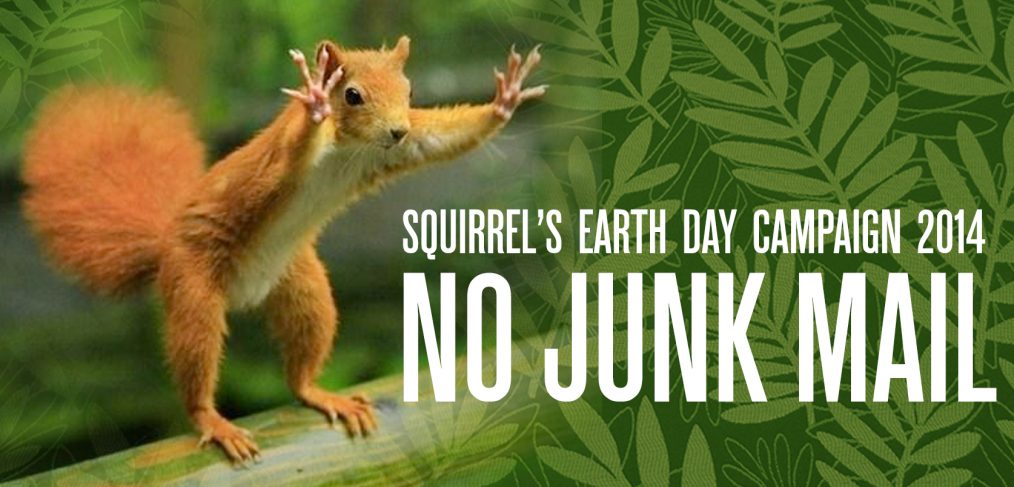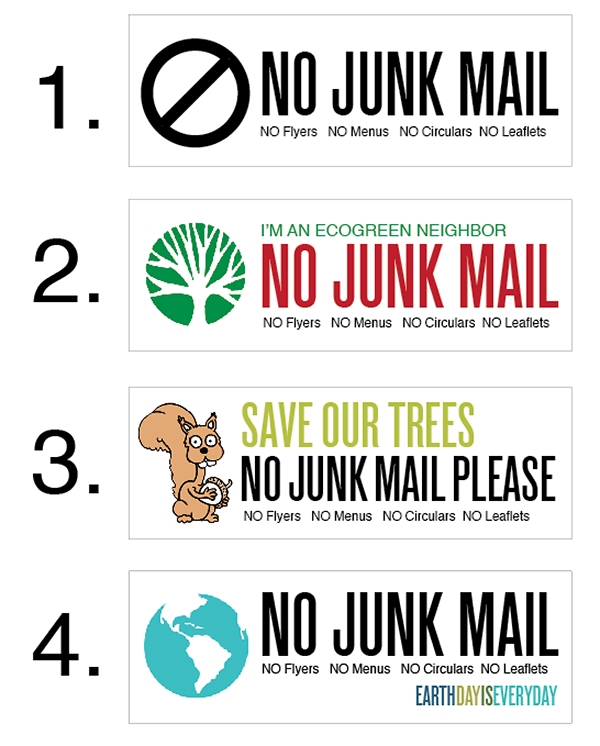
Earth Day 2014
Squirrel’s No Junk Mail Campaign
I don’t know about you, but I’m throwing away piles of junk mail each week. I’ve had enough! So I’m making a sticker for my door…and offering you one too! What’s the cost? Nothing. Why am I doing it? Well, because I’m an advocate of reducing waste, living simply and loving the earth – and I bet you are too!
Get Your Free Sticker – Easy Peasy!
OFFER EXPIRES MAY 2014
Just fill in the form below with your design choice:
(stickers are small and tasteful, 3.5″ x 1.5″)

[ccf_form id=”5753″]
If you think you’re too small to make a difference, try sleeping with a mosquito – The Dalai Lama
More Info:
- 5.6 million tons of catalogs and other direct mail advertisements end up in U.S. landfills annually.
- The average American household receives unsolicited junk mail equal to 1.5 trees every year—more than 100 million trees for all U.S. households combined.
- 44 percent of junk mail is thrown away unopened, but only half that much junk mail (22 percent) is recycled.
- Americans pay $370 million annually to dispose of junk mail that doesn’t get recycled.
- On average, Americans spend 8 months opening junk mail in the course of their lives.
What Else You Can Do
Register Your Name to Reduce Junk Mail
OK, now that you’ve decided to reduce the volume of junk mail you receive, how do you go about it? Start by registering with the Mail Preference Service of the Direct Marketing Association (DMA). It won’t guarantee you a life free of junk mail, but it can help. DMA will list you in its database in the “Do Not Mail” category. Direct marketers are not required to check the database, but most companies that send large volumes of bulk mail do use the DMA service. They realize there is no percentage in routinely sending mail to people who don’t want it and have taken action to prevent it.
Get Off Junk Mail Lists
You can also go to OptOutPreScreen.com, which can enable you to remove your name from lists that mortgage, credit card and insurance companies use to mail you offers and solicitations. It’s a centralized website run by the four major credit bureaus in the United States: Equifax, Experian, Innovis and TransUnion.
Most businesses check with one or more of these companies before accepting your credit card or granting you credit for a long-term purchase. They are also a huge source of names and addresses for credit card, mortgage and insurance companies that routinely send junk mail to attract new customers and solicit new business. But there’s a way to fight back. The federal Fair Credit Reporting Act requires credit bureaus to delete your name from their rented lists if you make the request.
Contact Companies That Send You Junk Mail
If you’re serious about ridding your life of as much junk mail as possible, then simply registering with these services may not leave enough space in your mailbox. In addition, you should ask all of the companies you patronize to place your name on their “do not promote” or “in-house suppress” lists.
If you do business with a company by mail, it should be on your contact list. That includes magazine publishers, any companies that send you catalogs, credit card companies, etc. It’s best to make this request the first time you do business with a company, because it will prevent them from selling your name to other organizations, but you can make the request at any time.
Keep Track of Your Name to Track How Junk Mail is Generated
As an extra precaution, some organizations recommend that you track where companies are getting your name by using a slightly different name whenever you subscribe to a magazine or begin a new mail relationship with a company. One strategy is to give yourself fictional middle initials that match the name of the company. If your name is Jennifer Jones and you subscribe to Vanity Fair, simply give your name as Jennifer V.F. Jones, and ask the magazine not to rent your name. If you ever receive a piece of junk mail from other companies addressed to Jennifer V.F. Jones, you’ll know where they got your name.
If this all still seems a bit daunting, there are resources to help you get through it. One option is to use the Stop the Junk Mail Kit developed by the Consumer Research Institute. A variety of other websites, such as unsubscribe.com and stopthejunkmail.com, provide further assistance or guidelines for reducing junk mail and other intrusions, from unwanted e-mail (spam) to telemarketing calls. Some of these services are free while others charge an annual fee.
So do yourself and the environment a favor. Keep the junk mail out of your mailbox and out of the landfill.



